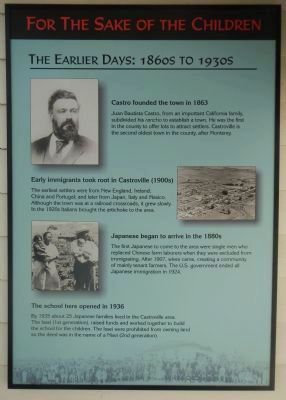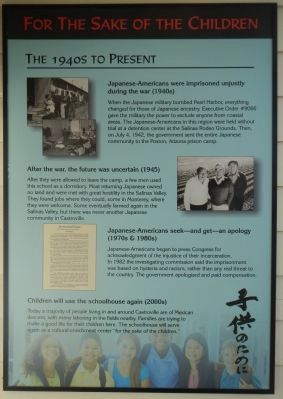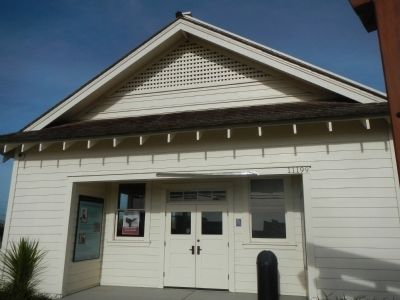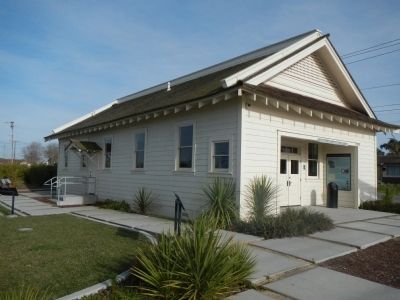Castroville in Monterey County, California — The American West (Pacific Coastal)
For the Sake of the Children
(The Japanese Schoolhouse)
Inscription.
The Early Days: 1860s to 1930s
Castro founded the town in 1863
Juan Bautista Castro, from an important California family, subdivided his rancho to establish a town. He was the first in the county to offer lots to attract settlers. Castroville is the second oldest town in the county, after Monterey.
Early immigrants took root in Castroville (1900s)
The earliest settlers were from New England, Ireland, China, and Portugal; and later from Japan, Italy and Mexico. Although the town was at a railroad crossroads, it grew slowly. In the 1920s Italians brought the artichoke to the area.
Japanese began to arrive in the 1880s
The first Japanese to come to the area were single men who replaced Chinese farm labors when they were excluded from immigrating. In 1907, wives came, creating a community of mainly tenant farmers. The U.S. government ended all Japanese immigration in 1924.
The school here opened in 1936
By 1935 about 25 Japanese families lived in the Castroville area. The Issei (1st generation), raised funds and worked together to build the school for the children. The Issei were prohibited from owning land so the deed was in the name of the Nisei (2nd generation).
The 1940s to the Present
Japanese-Americans were imprisoned unjustly during the war (1940s)
When the Japanese military bombed Pearl Harbor, everything changed for those of Japanese ancestry. Executive Order #9066 gave the military the power to exclude anyone from coastal areas. The Japanese-Americans in this region were held without trial at a detention center in the Salinas Rodeo Grounds. Then, on July 4, 1942, the government sent the entire Japanese community to the Poston, Arizona prison camp.
After the war, the future was uncertain (1945)
After they were allowed to leave the camp, a few men used this school as a dormitory. Most returning Japanese owned no land and were met with great hostility in the Salinas Valley. They found jobs where they could, some in Monterey, where they were welcome. Some eventually farmed again in the Salinas Valley, but there was never another Japanese community in Castroville.
Japanese-Americans seek – and get – an apology (1970s & 1980s)
Japanese-Americans began to press Congress for acknowledgment of the injustice of their incarceration. In 1982, the investigating commission said the imprisonment was based on hysteria and racism, rather than any real threat to the county. The government apologized and paid compensation.
Children will use the schoolhouse again (2000s)
Today the majority of people living in and around Castroville
are of Mexican descent, with many laboring in the fields nearby. Families are trying to make a good life for their children here. The schoolhouse will serve again as a cultural enrichment center “for the sake of the children.”
Erected by California State Parks.
Topics. This historical marker is listed in these topic lists: Asian Americans • Education. A significant historical month for this entry is July 1821.
Location. 36° 45.903′ N, 121° 45.078′ W. Marker is in Castroville, California, in Monterey County. Marker is on Geil Street near Pajaro Street, on the right when traveling west. Touch for map. Marker is at or near this postal address: 11191 Geil Street, Castroville CA 95012, United States of America. Touch for directions.
Other nearby markers. At least 8 other markers are within 8 miles of this marker, measured as the crow flies. The Castroville Japanese Schoolhouse (here, next to this marker); Juan B. Castro (approx. 0.4 miles away); Post 694 (approx. 5.3 miles away); José Eusebio Boronda Adobe Casa (approx. 6 miles away); Company C 194th Tank Battalion (approx. 6 miles away); Eugene Sherwood (approx. 7.4 miles away); The First and Second Filipino Infantry Regiments U.S. Army (approx. 7½ miles away); Salinas Temporary Detention Center (approx. 7.6 miles away). Touch for a list and map of all markers in Castroville.
More about this marker. This marker is composed of two panels located on either side of the schoolhouse entrance.
Additional keywords. immigration
Credits. This page was last revised on June 16, 2016. It was originally submitted on March 16, 2013, by Barry Swackhamer of Brentwood, California. This page has been viewed 679 times since then and 30 times this year. Photos: 1, 2, 3, 4. submitted on March 16, 2013, by Barry Swackhamer of Brentwood, California. • Bill Pfingsten was the editor who published this page.



